Trust Fund
-
- Moving Ahead With the Harbor Maintenance Trust Fund Marine News, Feb 2015 #21
“How can we have a 21st century economy with a 20th century infrastructure?” Vice President Joe Biden recently posed this question to an audience at the American Association of Port Authorities (AAPA) annual meeting in Houston, Texas. He went on to say, “the greatest economic power in the world needs the most dynamic port system in the world.” I happen to agree with this statement. We must find a better way to manage the funding needs of our marine transportation infrastructure. In fact, you will find many politicians, business leaders, economists, and transportation specialists that are quite outspoken on this matter. It seems everybody talks infrastructure, and how deteriorated our roads, rails, highways, bridges, and ports have become. But all these fundamental transportation systems are still continuing to deteriorate.
We were all encouraged by the passage of the Water Resources and Reform Development Act of 2014 (WRRDA), and the acknowledgement by substantial votes in both the House and Senate that our ports and waterways need additional investment and more resources to maintain the channels, harbors and waterways. A lot of effort went into educating the large number of House members that had never experienced or even heard of a WRRDA bill.
The WRRDA bill authorized improvements to several deep-draft ports, and authorized a phased-in funding approach of the Harbor Maintenance Trust Fund for maintenance dredging of ports and harbor infrastructure. But this has not solved the problem, and we still have 20th century infrastructure, not able to support our 21st century economy.
How can this be, you might ask? WRRDA authorizes Congress to implement these funding approaches, but it does not mandate this investment strategy. The Appropriations Committees must actually make the decisions on how these navigation infrastructure projects will be funded. What makes the lack of funds for maintenance of the ports and harbors even more frustrating is the fact that Congress, back in the 20th century, 1986 to be exact, passed a WRDA that established the Harbor Maintenance Trust Fund. The Harbor Maintenance Trust Fund and its Harbor Maintenance Tax were authorized in the Water Resources Development Act of 1986, P.L. 99-662. The purpose of the Tax, a 0.125% ad valorem tax levied on cargo imported or domestically moved through federally maintained channels and harbors, is to pay for Army Corps of Engineers operations and maintenance dredging.
The Tax is collected by the Bureau of Customs and Border Protection and directed to the Trust Fund. However, the monies are not immediately eligible for dredging activities. Those monies can only be spent if the funding is actually appropriated by Congress. The Trust Fund has continued to increase and now has a surplus in excess of $8 billion dollars. The reason for the large surplus is that only a little more than half of the annual revenues collected are appropriated for maintenance of the harbors and ports. Last year, $1.6 billion were collected, but the Corps was only reimbursed $979 million. So, since 1986, the shippers have been paying a tax that is supposed to fund the maintenance needs of Federal ports and harbors. But, it has not worked out as authorized by the law. One could quickly conclude that we have been in port infrastructure denial. There is no easy way to resolve this as long as the Harbor Maintenance Trust Fund monies for maintenance must be appropriated and subject to the political vulnerabilities of the current budget process.
I keep wondering why we would want to subject our ports and waterways to this burden of political process and continued uncertainty. For the most part, these Federal navigation projects have gone through a rigorous economic evaluation, public comment, environmental compliance review, and in many cases, hundreds of millions of dollars have been invested to develop these ports and waterways, and yet these projects only receive a percentage of the actual maintenance dollars they need to keep the channels at full project dimensions (width and depth).
These ports and waterways serve us all, and are the lifeblood of our economic engine. Why would we want to allow them to deteriorate, and not be able to receive the commodities we need, and to export the grain, coal, and manufactured goods that make our Nation strong? We must find a way to keep our ports and waterways fully capable of supporting the increasing flow of goods efficiently and ensure our ability to compete in world markets.
It is time to legislate solutions, not just continue to talk about how bad our maritime infrastructure has become. It will be challenging and it will require bipartisan support. Early on, in the 114th Congress, we are hearing discussions about our highway infrastructure, and the need for a tax increase. To hear this rhetoric from leadership gives me hope that maybe a 2016 WRDA can offer a solution that will not just kick the infrastructure can to another day, or pass the responsibility to another Committee. There is a solution. The revenue is there, and now is the time to fully use the Harbor Maintenance Trust Fund tax for its intended purpose. Now is the time to move our ports and harbors into the 21st century.
(As published in the February 2015 edition of Marine News - http://magazines.marinelink.com/Magazines/MaritimeNews)
-
- Op/Ed: Disconnect from River to Washington Marine News, Mar 2018 #24
companies across the entire national system – are the only beneficiary to contribute 29-cents-per-gallon diesel fuel tax to a dedicated Inland Waterways Trust Fund, matched by General Treasury Funds, that pays for the costs of construction and major rehabilitation of the system. Other system beneficiaries –
-
- Corps Of Engineers Asked To Fund More Renovations On Inland Waterways Maritime Reporter, May 1992 #57
rehabilitation will decide the fate of the waterway industry's plan, said federal and commercial officials. Under present requirements, the waterways trust fund, financed through fuel taxes on towboats, must supply half the money for major rehabilitation work. However, new rules proposed last year by
-
- FY 1993 Budget For Coast Guard Shows Increase Over FY 1992 Maritime Reporter, May 1992 #71
the funding are: —$142.1 million to be funded by the Department of Defense for transfer to Coast Guard; —$31.9 million from the Oil Spill Liability Trust Fund; —$35 million from the Boat Safety account. Capital Improvement—The $414-million request funds continued replacement and modernization of major
-
- Congress Gets It Done with WRRDA Marine News, Jul 2014 #20
WCI: Olmsted Federalization: permanent cost-sharing for the remaining cost of the Olmsted project will be 85% General Fund, 15% Inland Waterways Trust Fund, freeing up approximately $105 million per year for funding other Trust Fund priority projects with Olmsted funded at $150 million per year.
-
- US Dredging Needs Growth as Army Corps’ Budget Shrinks Marine News, Jun 2014 #34
appropriated $1.086 billion in FY 2014, up slightly from the previous year, to USACE for navigation projects reimbursed by the Harbor Maintenance Trust Fund. The federal Harbor Maintenance Tax, established in 1986, is imposed on shippers based on the value of goods moving through ports. The tax is no
-
- WRDA to the Wise Marine News, Jun 2013 #14
(D-MN), Sen. Lamar Alexander (R-TN), Sen. Tom Harkin (D-IA), Sen. Al Franken (D-MN), and Sen. Pat Roberts (R-KS). They are: Changing Inland Waterways Trust Fund (IWTF) cost-sharing for the over-budget Olmsted lock and dam project, with the remainder of the cost of the project to be paid 100% by general treasury
-
- Insights: Tracy Zea, Director-Government Relations, WCI Marine News, Sep 2015 #12
few other important milestones for us. Recent highlights include the cost-share for Olmsted Lock and Dam being changed from 50 percent Inland Waterways Trust Fund/50 percent General Fund to 15 percent Inland Waterways Trust Fund/ 85 percent General Fund. This will free more Trust Fund dollars to be spent on
-
- Rethinking Inland Infrastructure Finance Marine News, Sep 2016 #20
, but with this difference: the 2013 studies included proposals to use some portion of the fuel tax revenues that are paid into the Inland Waterways Trust Fund to provide the necessary debt service and return on equity for such financing. Sorting out the Funding Rules The use of funds received by the
-
- Federal Waterways Infrastructure Outlook Marine News, Nov 2017 #62
emerge between the Administration and Congress. For example, the Administration does not propose spending all of the money in the Inland Waterways Trust Fund (IWTF), paid for by the $0.29/gallon tax on maritime diesel fuel. To be fair, President Obama similarly withheld trust fund revenue, but for FY18
-
- A Gift to US Inland Waterways Marine News, Feb 2015 #26
user fee. The increase will be effective April 1, 2015 and funds – around $40 million from industry levies – will be deposited into the Inland Waterways Trust Fund for the benefit of priority navigation project construction and major rehabilitation. On December 3, 2014, the House of Representatives passed
-
- US Inland Waterways: Cheer the Year! Marine News, Dec 2020 #8
level enacted by Congress.Beyond the reduction to the Corps’ budget, most disappointing in the budget was a request for $0 from the Inland Waterways Trust Fund (IWTF) for construction of inland waterways lock projects. The FY20 Administration budget requested $111 million for the Lower Mon project near Pittsburgh
-
 )
March 2024 - Marine Technology Reporter page: 42
)
March 2024 - Marine Technology Reporter page: 42BIRNS MacArtney launches the new ultra-compact ø12.7 mm SubConn Nano connector. Innovative connectivity built on 45 years of ? eld-proven and market-trusted design. Image courtesy MacArtney Birns celebrated its 70th anniversary at Oi. Cables & Connectors CABLES & CONNECTORS BIRNS made a splash at Oi
-
 )
April 2024 - Maritime Reporter and Engineering News page: 39
)
April 2024 - Maritime Reporter and Engineering News page: 39Tech Files Latest Products, Systems and Ship Designs “Wall Climbing Robot” Danish Pilot calls gets ClassNK Nod LEGO Model "A tribute build to a work life at sea" Image courtesy MOL, Sumitomo Heavy Industries lassNK granted its Innovation Endorse- Image courtesy Espen Andersen/DanPilot ment for
-
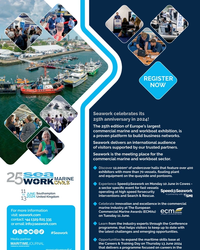 )
April 2024 - Maritime Reporter and Engineering News page: 7
)
April 2024 - Maritime Reporter and Engineering News page: 7marine and workboat exhibition, is a proven platform to build business networks. Seawork delivers an international audience of visitors supported by our trusted partners. Seawork is the meeting place for the commercial marine and workboat sector. 2 Discover 12,000m of undercover halls that feature over
-
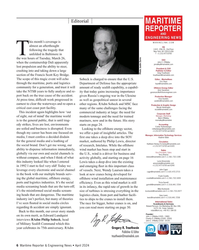 )
April 2024 - Maritime Reporter and Engineering News page: 6
)
April 2024 - Maritime Reporter and Engineering News page: 6Haun through the maritime, ports and logistics Department of Defense has the appropriate [email protected] community for a generation, and trust it will amount of ready sealift capability, a capabil- Offshore Energy Editor Amir Garanovic take the NTSB years to fully analyze and re- ity that
-
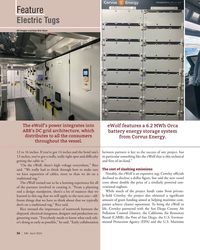 )
April 2024 - Marine News page: 34
)
April 2024 - Marine News page: 34Feature Electric Tugs All images courtesy Eric Haun The eWolf’s power integrates into eWolf features a 6.2 MWh Orca ABB’s DC grid architecture, which battery energy storage system distributes to all the consumers from Corvus Energy. throughout the vessel. 12 to 16 inches. If you’ve got 14 inches and
-
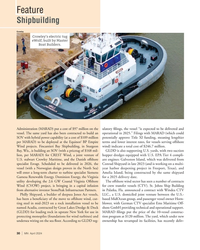 )
April 2024 - Marine News page: 30
)
April 2024 - Marine News page: 30Feature Shipbuilding Crowley Crowley’s electric tug eWolf, built by Master Boat Builders. Administration (MARAD) put a cost of $97 million on the ulatory ? lings, the vessel “is expected to be delivered and vessel. The same yard has also been contracted to build an operational in 2025.” Filings with
-
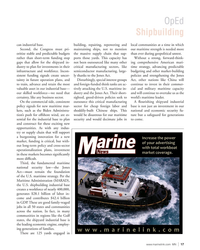 )
April 2024 - Marine News page: 17
)
April 2024 - Marine News page: 17OpEd Shipbuilding can industrial base. building, repairing, repowering and local communities at a time in which Second, the Congress must pri- maintaining ships, not to mention our maritime strength is needed more oritize stable and predictable budgets the massive supply chain that sup- than ever
-
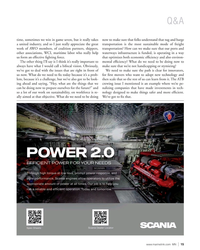 )
April 2024 - Marine News page: 15
)
April 2024 - Marine News page: 15Q&A time, sometimes we win in game seven, but it really takes now to make sure that folks understand that tug and barge a united industry, and so I just really appreciate the great transportation is the most sustainable mode of freight work of AWO members, of coalition partners, shippers, transportation?
-
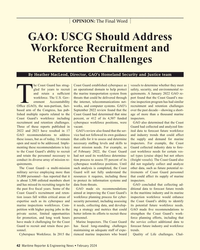 )
February 2024 - Maritime Reporter and Engineering News page: 42
)
February 2024 - Maritime Reporter and Engineering News page: 42OPINION: The Final Word GAO: USCG Should Address Workforce Recruitment and Retention Challenges By Heather MacLeod, Director, GAO’s Homeland Security and Justice team he Coast Guard has strug- Coast Guard established cyberspace as vessels to determine whether they meet gled for years to recruit an
-
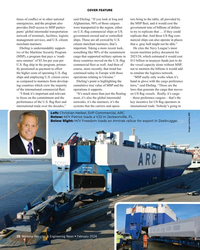 )
February 2024 - Maritime Reporter and Engineering News page: 28
)
February 2024 - Maritime Reporter and Engineering News page: 28COVER FEATURE times of con? ict or in other national said Ebeling. “If you look at Iraq and tors bring to the table, all provided by emergencies, and the program also Afghanistan, 98% of those cargoes the MSP ? eet, and it would cost the provides DoD access to MSP partici- were transported to the
-
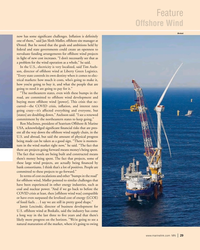 )
February 2024 - Marine News page: 29
)
February 2024 - Marine News page: 29Feature Offshore Wind Ørsted now has some signi? cant challenges. In? ation is de? nitely one of them,” said Jan Sloth Møller, offshore site manager at Ørsted. But he noted that the goals and ambitions held by federal and state governments could create an openness to reevaluate funding arrangements for
-
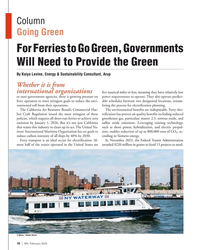 )
February 2024 - Marine News page: 16
)
February 2024 - Marine News page: 16Column Going Green For Ferries to Go Green, Governments Will Need to Provide the Green By Kaiya Levine, Energy & Sustainability Consultant, Arup Whether it is from international organizations ? ve nautical miles or less, meaning they have relatively low or state government agencies, there is growing
-
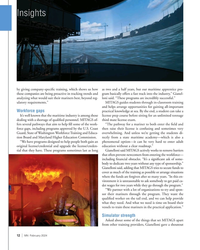 )
February 2024 - Marine News page: 12
)
February 2024 - Marine News page: 12by giving company-speci? c training, which shows us how as two and a half years, but our maritime apprentice pro- these companies are being proactive in tracking trends and gram basically offers a fast track into the industry,” Gianel- analyzing what would suit their mariners best, beyond reg- loni said.
-
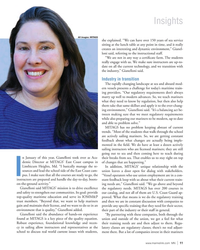 )
February 2024 - Marine News page: 11
)
February 2024 - Marine News page: 11and not all of them are U.S. Coast Guard ap- top-quality maritime education and serve its IOMM&P proved. What that means is we do the regulatory training trust members. “Beyond that, we want to help mariners and then we are in constant discussion with companies to gain and maintain their license, and we
-
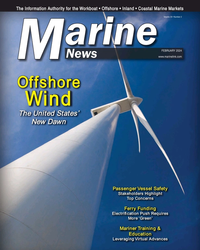 )
February 2024 - Marine News page: Cover
)
February 2024 - Marine News page: CoverThe Information Authority for the Workboat • Offshore • Inland • Coastal Marine Markets Volume 35 • Number 2 arine FEBRUARY 2024 www.marinelink.com News M Offshore Wind The United States’ New Dawn Passenger Vessel Safety Stakeholders Highlight Top Concerns Ferry Funding Electrifcation Push Requires
-
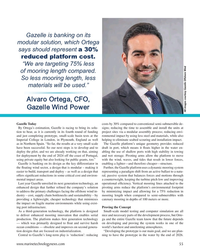 )
January 2024 - Marine Technology Reporter page: 55
)
January 2024 - Marine Technology Reporter page: 55Gazelle is banking on its modular solution, which Ortega says should represent a 30% reduced platform cost. “We are targeting 75% less of mooring length compared. So less mooring length, less materials will be used.” Alvaro Ortega, CFO, Gazelle Wind Power All images courtesy Gazelle Offshore Wind Gaze
-
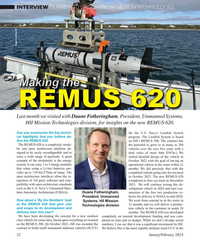 )
January 2024 - Marine Technology Reporter page: 22
)
January 2024 - Marine Technology Reporter page: 22INTERVIEW DUANE FOTHERINGHAM, HII MISSION TECHNOLOGIES Image courtesy HII REMUS 620 Last month we visited with Duane Fotheringham, President, Unmanned Systems, HII Mission Technologies division, for insights on the new REMUS 620. Can you summarize the key techni- for the U.S. Navy’s Lion? sh System cal
-
 )
January 2024 - Marine Technology Reporter page: 18
)
January 2024 - Marine Technology Reporter page: 18TECH FEATURE WAVE POWER All images courtesy Mocean Energy MOCEAN ENERGY AIMS TO CREATE AN OFFSHORE RENEWABLE MICROGRID Garnering power from ocean waves is a generation behind the progress of offshore wind, but Mocean Energy, led by founder and managing director Cameron McNatt, is aiming to help offshore
-
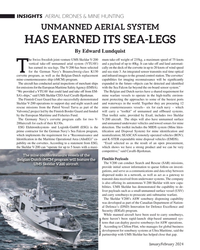 )
January 2024 - Marine Technology Reporter page: 12
)
January 2024 - Marine Technology Reporter page: 12INSIGHTS AERIAL DRONES & MINE HUNTING UNMANNED AERIAL SYSTEM HAS EARNED ITS SEA-LEGS By Edward Lundquist he Swiss-Swedish joint-venture UMS Skeldar V-200 mum take-off weight of 235kg, a maximum speed of 75 knots vertical take-off unmanned arial system (VTUAV) and a payload of up to 40kg. It can take
-
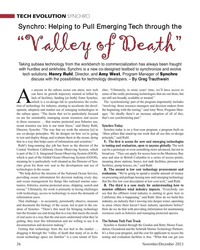 )
November 2023 - Marine Technology Reporter page: 26
)
November 2023 - Marine Technology Reporter page: 26of the really promising technologies that are out there, but lack of facilities, funding [or both]. Enter Synchro, are still not broadly available or trusted.” which is a co-design lab to synchronize the evolu- The ‘synchronizing’ part of the program importantly includes A tion of technology for industry
-
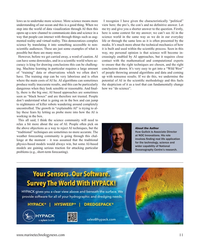 )
November 2023 - Marine Technology Reporter page: 11
)
November 2023 - Marine Technology Reporter page: 11or reasonable. And ? nal- how we “do science”. ly, there is the big one; AI based approaches are sometimes seen as “black boxes” and are therefore not trusted. People don’t understand what is going on in the box and can jump to nightmares of killer robots wandering around completely uncontrolled. The
-
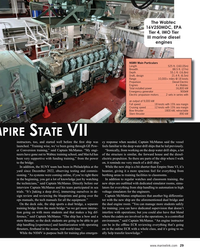 )
December 2023 - Maritime Reporter and Engineering News page: 29
)
December 2023 - Maritime Reporter and Engineering News page: 29The Wabtec 16V250MDC, EPA Tier 4, IMO Tier III marine diesel engines NSMV Main Particulars Length 525 ft. (160.05m) Breadth 88.5 ft. (27m) Depth 55.1 ft. (16.8m) Draft, design 21.4 ft. (6.5m) Range 10,000+ miles @ 18 knots Propulsion Diesel Electric Engines 4 x Wabtec Total installed power 16
-
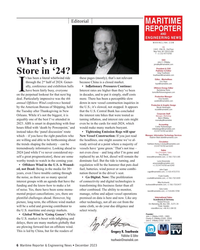 )
December 2023 - Maritime Reporter and Engineering News page: 6
)
December 2023 - Maritime Reporter and Engineering News page: 6Editorial MARITIME REPORTER AND ENGINEERING NEWS M A R I N E L I N K . C O M HQ 118 E. 25th St., 2nd Floor New York, NY 10010 USA T +1 212 477 6700 CEO John C. O’Malley What’s in [email protected] President & COO Publisher & Editor Greg Trauthwein Store in ‘24? [email protected] t has
-
 )
November 2023 - Marine News page: 44
)
November 2023 - Marine News page: 44Length: 525 ft. Breadth: 88.5 ft. Feature Depth: 55.1 ft. Draft, design: 21.4 ft. Range: 10,000+ miles @ 18 knots Propulsion: Diesel Electric Great Vessels of 2023 Engines: Wabtec (4) separated in two engine rooms MARAD Total installed power: 16,800 kW Emergency generator: 900kW Electric propulsion
